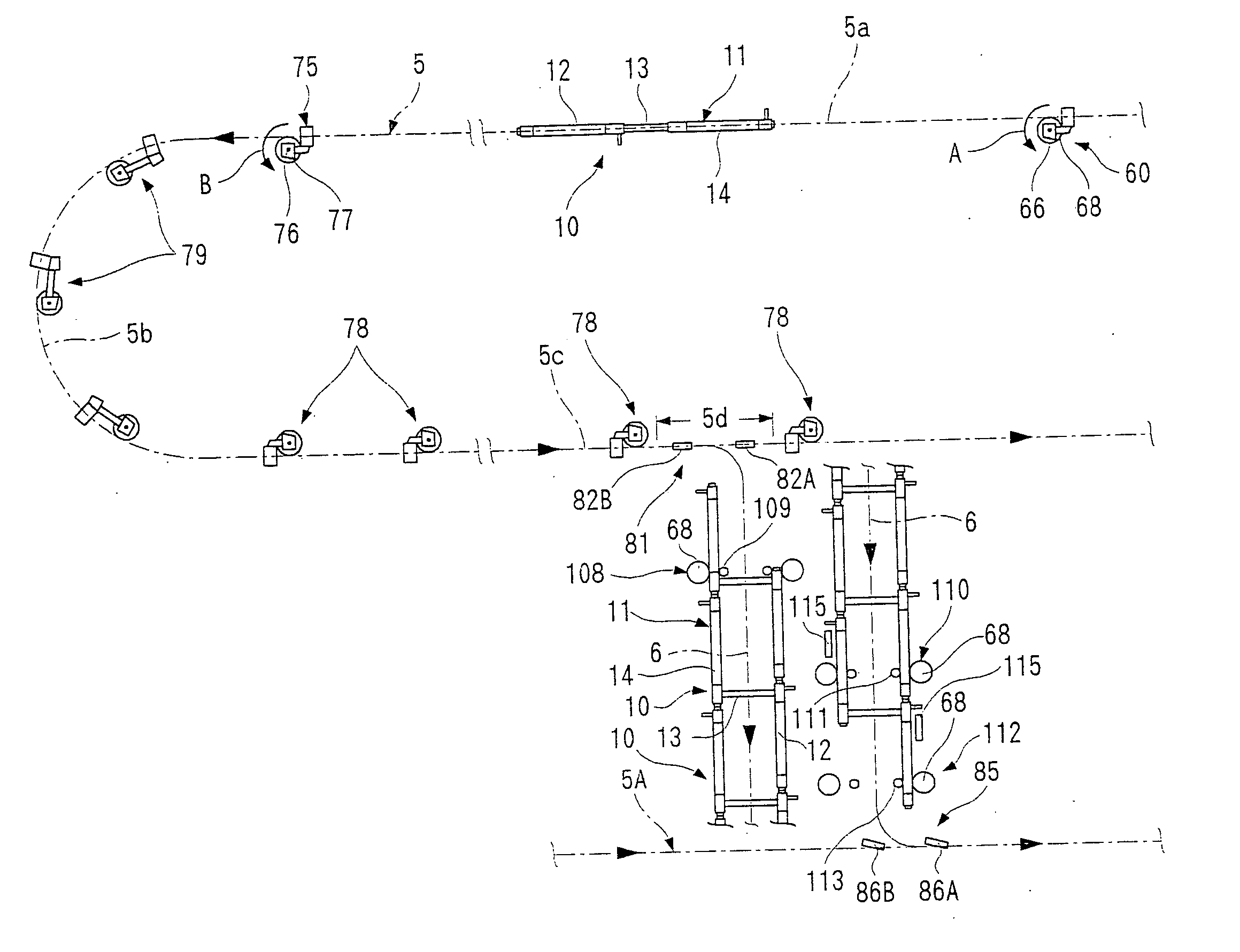Conveyance apparatus using movable body
- Summary
- Abstract
- Description
- Claims
- Application Information
AI Technical Summary
Benefits of technology
Problems solved by technology
Method used
Image
Examples
first embodiment
[0062] the present invention is described below in a mode applied to a ceiling-located travel system for movable bodies, with reference to FIG. 1-FIG. 20.
[0063] In FIG. 2 to FIG. 8, a main rail 2 having an I-shaped cross section is provided on a ceiling-mounted machine frame 1. This main rail 2 forms a fixed path 5. Here, the fixed path 5 comprises, in plan view, for example, a pair of parallel linear shaped path sections 5a, 5c, and a curved path section 5b which connects between the front and end portions of the linear shaped path sections 5a, 5c, and the like.
[0064] A portion of one of the pair of linear shaped path sections 5c is formed into a prescribed region 5d, and a working path section 6 is formed orthogonally on one side of this prescribed region 5d. Moreover, a separate fixed path 5A which is orthogonal to the working path section 6 and parallel to the linear path section 5c is similarly formed by a main rail 2A, or the like, having an I-shaped cross-section.
[0065] A m...
second embodiment
[0128] Next, the present invention is described on the basis of FIG. 21 toFIG. 24. More specifically, branching means 121 comprises two divided rail members 122A, 122B capable of supporting the guided devices 30, 40, formed by dividing the main rail 2 at a prescribed region 5d, and rotating devices 131A, 131B which cause these divided rail members 122A, 122B to rotate about vertical axes 123A, 123B. The divided rail members 122A, 122B are constituted in such a manner that when rotated and separated from the main rail 2, they can be connected to lateral travel rail members 80A, 80B.
[0129] In order to rotate the two divided rail members 122A, 122B about the vertical axes 123A, 123B, bearings 125A, 125B are provided on beams 124A, 124B, and the divided rail members 122A, 122B are connected to the lower end of vertical axles 126A, 126B supported rotatably on the bearings 125A, 125B.
[0130] The rotating devices 131A, 131B which cause the divided rail members 122A, 122B to rotate about th...
third embodiment
[0139] Next, the present invention will be described on the basis of FIG. 25 and FIG. 26.
[0140] In this third embodiment, a configuration of lateral travelling is achieved wherein a movable body 10 does not pass through the prescribed region 5d when it reaches it, but rather is always moved onto a working path section 6. More specifically, as illustrated in FIG. 25, the branching means 140 is provided in one place, commonly for both the lateral travel rail members 80A, 80B, and it comprises a rail member 141 which connects to the final end of the main rail 2, and an operating device (cylinder device, or the like) 143 for causing this rail member 141 to rotate about the axis of a vertical axle 142. A composition is adopted wherein when the rail member 141 is rotated, the upstream end thereof remains connected to the main rail 2 at all times, and the downstream end thereof connects selectively with one of the two lateral travel rail members 80A, 80B.
[0141] As illustrated in FIG. 26, ...
PUM
 Login to View More
Login to View More Abstract
Description
Claims
Application Information
 Login to View More
Login to View More - R&D
- Intellectual Property
- Life Sciences
- Materials
- Tech Scout
- Unparalleled Data Quality
- Higher Quality Content
- 60% Fewer Hallucinations
Browse by: Latest US Patents, China's latest patents, Technical Efficacy Thesaurus, Application Domain, Technology Topic, Popular Technical Reports.
© 2025 PatSnap. All rights reserved.Legal|Privacy policy|Modern Slavery Act Transparency Statement|Sitemap|About US| Contact US: help@patsnap.com



